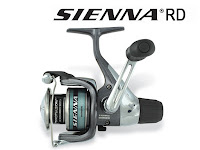Lures - Inline Spinner
Off
 |
| Famous Mepps Inline Spinner |
One of my all time favorite lures. It cast well, creates lots of flash, generates plenty of vibration & most important of all, it catches fish. I use this lure mainly for Haruan fishing ( Striped Snakehead ). Actually, the number one reason I like about this lure is, you can easily construct it at home. DIY style & still catches fish. The construction is simple to understand. Basically, an Inline Spinner consist of three major components, an optional fourth part is the trailer & some dressing.
Blade - this serves dual functions. It rotates when retrieved, therefore creating flash as well as vibrations. The faster you retrieve, the more vibrations it creates as it rotates faster. Personally, I prefer to use lighter, oval shaped blades as it begins spinning almost immediately with the slowest retrieve. The blade should also have a shinny coating to create plenty of flash.
Weight - this serves as additional weight to allow longer distance casting. Personally I prefer to use a bullet sinker in front & a hollow ball sinker at the rear.
Hook - Depending on where you intend to fish. If fishing in a relatively snag free, open water environment, use treble hooks for easier hook up. If fishing in weedy, snag infested waters, use single hook for lesser chance of snagging.
Trailer/Dressing - Some fishes respond better to spinners with a trailer or dressing. This could be flash strings, soft plastics baits or even fly.
How to use Inline Spinner
The way to use Inline Spinners is to cast out to distance. Pause for a min to let it sink to the bottom, the blades would flutter while sinking. Once it reaches bottom, jerk the lure a little & start a steady retrieve. Once you start feeling there is a faint vibration in your rod, you'll know the blades are spinning. This is assuming you are fishing with braided lines. Pause every few 5 to 10m to allow it to sink again.
Here is a step by step instruction on how to construct an Inline Spinner lure for rigging Soft Plastic bait.
You'll need the following materials & tools.
- 100lb hard wire leader
- Spinner blade
- Clevis
- Beads
- Sinker
- Hook
- Round nose pliers (tool)
- Cutter (tool)
 |
| (1) Make a loop. Add a bead. |
 |
| (2) Add clevis attached with blade. |
 |
| (3) Add sinkers. |
 |
| (4) Terminate end with another loop. Add split ring. |
 |
| (5) Done! Attached hook & trailer. |
 |
| It should look something like this. |
Additional modifications can be made to the spinner by swapping different hooks & trailers to fish in different environments.
 |
| Live bait spinning. Minnow or a frog. |
 |
| Fly spinning. |
 |
| Bare treble hooks. |
















































